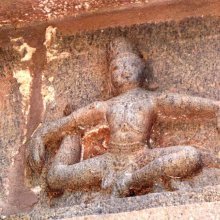Samasuci, Samasūcī, Sama-suci: 2 definitions
Introduction:
Samasuci means something in Hinduism, Sanskrit. If you want to know the exact meaning, history, etymology or English translation of this term then check out the descriptions on this page. Add your comment or reference to a book if you want to contribute to this summary article.
Alternative spellings of this word include Samasuchi.
Images (photo gallery)
In Hinduism
Natyashastra (theatrics and dramaturgy)
Source: Shodhganga: The significance of the mūla-beras (natya)Samasūcī (समसूची) refers to one of the nine maṇḍala (postures of the feet) which represents one of the four “movements of the feet” (pāda) according to the Abhinayadarpaṇa. The ninth maṇḍala is the samasūcī-maṇḍala where the toes as well as the knees touch the ground. The yogāsana posture in iconography is the same as this posture. This posture signifies the disciplining of the five senses. One of the hands is held in jñāna-mudrā close to the chest, with the palm facing either inward or outward. The other hand is placed on the thigh with the palm upward and the fingers held together and extended. The head is held erect with eyes gazing at the tip of the nose. Except for the yogāsana posture, there are no similar postures with the āsanas practiced in yoga.

Natyashastra (नाट्यशास्त्र, nāṭyaśāstra) refers to both the ancient Indian tradition (shastra) of performing arts, (natya—theatrics, drama, dance, music), as well as the name of a Sanskrit work dealing with these subjects. It also teaches the rules for composing Dramatic plays (nataka), construction and performance of Theater, and Poetic works (kavya).
Languages of India and abroad
Kannada-English dictionary
Source: Alar: Kannada-English corpusSamasūci (ಸಮಸೂಚಿ):—[noun] (dance.) a stretching of the leg as to make the heel, shank and the bottom of the thigh touch the ground.
Kannada is a Dravidian language (as opposed to the Indo-European language family) mainly spoken in the southwestern region of India.
See also (Relevant definitions)
Partial matches: Cama, Sama, Shuci.
Ends with: Vishamasuci.
Relevant text
No search results for Samasuci, Samasūcī, Sama-suci, Sama-sūcī, Samasūci, Sama-sūci; (plurals include: Samasucis, Samasūcīs, sucis, sūcīs, Samasūcis, sūcis) in any book or story.
